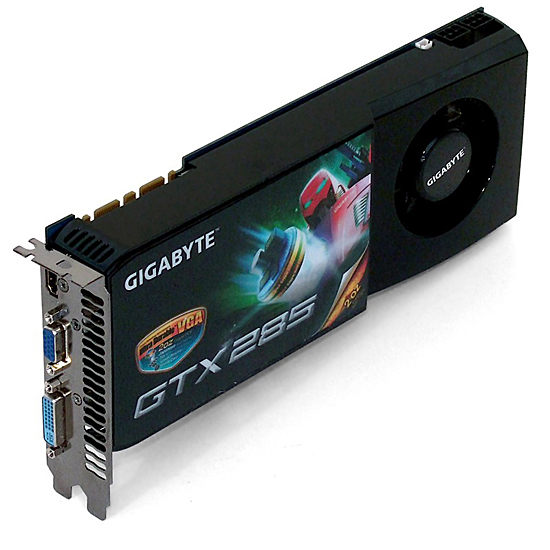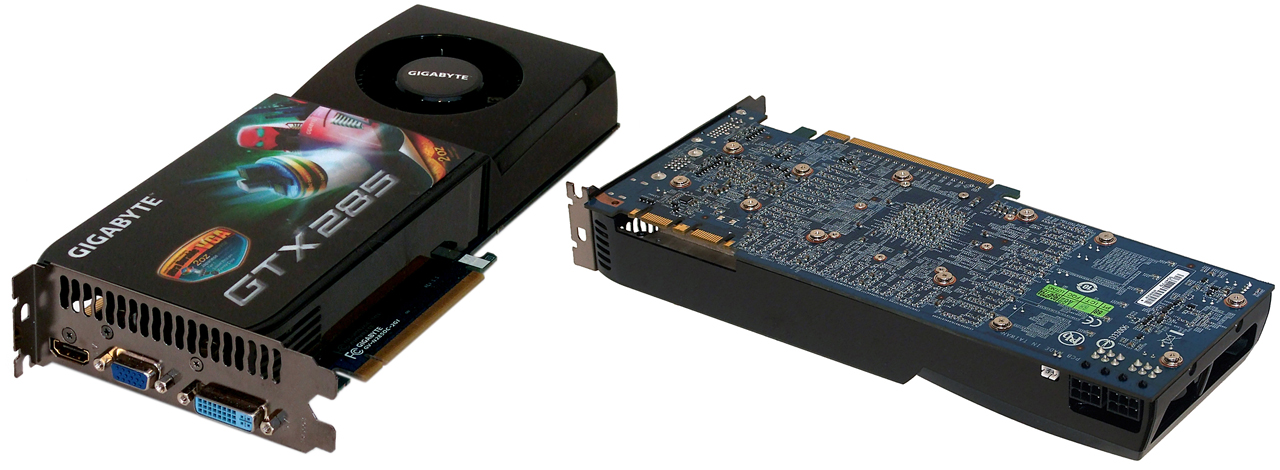GeForce GTX 285 Gets 2 GB: Gigabyte's GV-N285OC-2GI
Wasn't 1 GB Already Enough?
Big memory capacity hasn’t always been specific to the highest-end graphics cards. It's actually still fairly common for vendors to put a bunch of inexpensive, low-speed memory on entry-level boards, hoping that big number would register as better performance to the folks who haven't yet wrapped their heads around the idea that a big frame buffer is of limited use to an underpowered GPU. The uninitiated would readily jump for the “better” specification they knew, rather than the faster graphics processor they didn't understand as well.
But gamers have since become better-educated with respect to hardware, and many of today’s mainstream cards use fewer of the same expensive memory components as their high-end counterparts. For mainstream and better parts, the economic incentive to expand the memory capacities of low-end cards is almost gone.
More recently, the industry has seen an explosion in both graphics processing and system demands, with games becoming increasingly complicated and gorgeous 30" displays supporting 2560x1600 pixel resolutions. Putting aside marketing tricks of the past, the high end just might be where memory really needs to expand.
You won’t find a higher-end graphics processor than Nvidia's GeForce GTX 285, and that’s why Gigabyte chose it as the first model to support two gigabytes of super-fast GDDR3-2400 memory. Hints of a custom design are seen in its combination of HDMI and VGA connections, rather than a fistful of adapters, and bold claims of a “2 ounce Copper Inner Layer” for its circuit board.
Spreading the VGA and DVI outputs across two connections rather than relying on a second DVI-I interface and adapters eliminated the space Nvidia’s reference design used for its S-Video/Composite combo interface. That’s no big loss to most of us, since those legacy TV outputs were only able to support ultra-low resolutions. Anyone putting this much effort into gaming on a home-theater display should certainly have HDMI, or at least DVI by now.
Gigabyte’s custom circuit board doesn’t look much different than the reference-design cards we’ve seen, though Gigabyte claims slight improvements in its voltage regulator components.
Hynix’s super-fast H5RS1H23MFR-N2C 1Gb GDDR3-2400 memory is clocked at its rated speed, though Gigabyte does overclock the GeForce GTX 285 GPU slightly to 660 MHz, compared to the standard 648 MHz. Unlike Gigabyte’s card, reference models also underclock RAM to a 2,322 MHz data rate.
Get Tom's Hardware's best news and in-depth reviews, straight to your inbox.
Current page: Wasn't 1 GB Already Enough?
Next Page Comparison Cards: When 1 GB Is Greater Than 1.8 GB-
twisted politiks ive had EVGA's GTX 285 for about two months now, nothing new in the memory departmentReply -
rambo117 wow... that was quite pointless, i was really expecting a good article but it was the same numbers basically, why not just have a single page with the average gains with 2gb vs 1gb (which was completely nonexistent anyways)Reply
-
astrodudepsu Well, all I can say is good try. Not some of your best work, but worth exploring nonetheless.Reply -
Crashman astrodudepsuWell, all I can say is good try. Not some of your best work, but worth exploring nonetheless.Reply
Tom's Hardware was hoping to find more 2560x1600 scenarios where the 2GB advantage would play out. When very few advantages were found, Tom's did the honest thing and published the numbers anyway.
I think you can take a lot from this article. I just spoke to a guy who asked "2GB or water cooling?" when looking at cards of the same price. He has a powerful water cooling loop, so the answer was easy. -
one-shot I think it is a great article. Too often people approach me thinking a larger frame buffer means extra performance. Actually, just recently a co-worker wanted to get a GTX 285 with 2GB of VRAM. Great article, keep it up!Reply -
SpadeM Just a quick question: Since the GTX285 is a high range card, those the same "1GB is enough" rule apply to mid range/low end cards?Reply
PS: I'm thinking slower GPU might benefit from more memory -
astrodudepsu CrashmanTom's Hardware was hoping to find more 2560x1600 scenarios where the 2GB advantage would play out. When very few advantages were found, Tom's did the honest thing and published the numbers anyway.Reply
Which is why I said it was worth exploring. I realize you wouldn't do all this work and NOT publish your results, as mundane as they may be. -
rambo117 it was quite informative and worth exploring like astrodude said. just wish that it was a little more 'exciting'.. idk, maybe an sli 2gb vs 1gb will prove to be possibley more interesting.Reply -
Hellbound If a card is going to cost $350-$400, and perform as much as %50 less than the car that costs $500....get the $500 card. You are already spending an insane amount for a card, might as well go all the way. As for me, I'm waiting for the DX11 cards to come out.Reply -
Crashman rambo117it was quite informative and worth exploring like astrodude said. just wish that it was a little more 'exciting'.. idk, maybe an sli 2gb vs 1gb will prove to be possibley more interesting.Reply
Three-way would have been best, but there's just not enough samples to go around.




